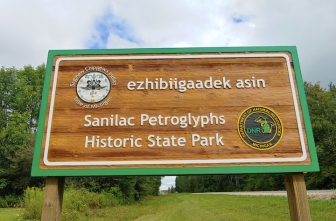
A sign in English and the Anishinabemowin language welcome visitors to Sanilac Petroglyphs State Historic Park. Image: Michigan History Center
By Sophia Brandt
LANSING – Sanilac Petroglyphs Historic State Park is looking to the future by adding new signs, kiosks and an updated pavilion to better reflect tribal voices.
The Sanilac park is run through a partnership of the Department of Natural Resources (DNR) Parks and Recreation Division, the state History Center and the Saginaw Chippewa Indian Tribe of Michigan.
The Sanilac petroglyphs – referred to as “ezhibiigaadek asin” by the tribe and meaning “knowledge written on stone” in the Anishinabemowin language – are teachings carved into the rock.
The park, in Sanilac County, is home to the largest collection of stone-carved Native American teachings in Michigan. They date back 300 to 1,000 years, according to the Cranbrook Art Museum in Bloomfield Hills, which has exhibited drawings of the petroglyphs.
Stacy Tchorzynski, a DNR archaeologist and park historian described one of the most prominent carvings at the park. It’s a figure of a man shooting an arrow.
The teaching says the man is not hunting, but rather shooting an arrow of knowledge into the future, she said.
The land was privately owned, and given to the state in 1971, when it became a state park.
Tchorzynski said collaboration between the department and the Saginaw Chippewa Tribe started early on, but didn’t become official until a final agreement in 2019 that solidified its relationship and ownership.
The signature of former Tribal Chief Ronald Ekdahl was the last needed to complete the 2019 memorandum of understanding, said Marcella Hadden and Willie Johnson in a joint email. Both work for the Ziibiwing Center of Anishinabe Culture & Lifeways in Mount Pleasant, where the tribe’s headquarters are located.
The co-ownership arrangement allows everything to be shared. Every decision is made by both parties.
“Over the years, we have learned how it is an absolute must to (put) tribal voices (in the forefront) and have them be the leaders in the interpretation of the site, especially at a site with this heritage,” Tchorzynski said.
That also includes sharing information the tribe thinks are important for the public to see, while keeping private information that is just for internal tribal knowledge, she said.

New interpretive signs at Sanilac Petroglyphs State Historic Park. Image: Michigan History Center
A similar process has been used for other public lands in the Great Lakes region where government agencies and tribes cooperate.
For example, the U.S. Forest Service agreed with Minnesota’s Leech Lake Tribal Council to discontinue interpreting the sacred site of Chippewa National Forest’s Turtle Oracle Mound, even though it’s listed on the National Register of Historic Places. Tourists are discouraged from going to the site.
Michigan has 12 federally acknowledged tribes.
The state website says Michigan shares a responsibility with the 12 tribes to “provide for and protect the health, safety and welfare of tribal community members.”
As a part of the Sanilac parks general management plan, Tchorzynski said signs are being replaced and new placards being installed, all of which are co-authored by the department and the tribe.
The plaques are one way the DNR makes sure tribal voices are heard, Tchorzynski said.
The new signs use phrases in the Anishinabemowin language, show archaeological pictures from discovery of the petroglyphs and talk about the plants and animals that call the park home.
Park leaders are looking into infrastructure improvements as well.
For example, the main structure that protects the petroglyphs is nearly 40 years old and needs replacement, Tchorzynski said.
The park needs a structure designed to meet “all the cultural needs of tribal partners and to maintain connectivity to the landscape,” she said.
Tchorzynski said that the new pavilion will be one of the biggest changes.
She said there are no cost estimates or designs ready yet and the project will take the next few years.
A grant to the tribe from the National Association of Tribal Historic Preservation Officers will pay for a land acknowledgment statement and National Register of Historic Places plaque, as well as an interactive kiosk on Anishinabemowin language and protocols, said Hadden and Johnson.
The plan also looks at DNR’s long-range goals for the park.
“It’s our job to make sure the park, that these carvings, last for the next several generations,” she said.
Sophia Brandt reports for Capital News Service.